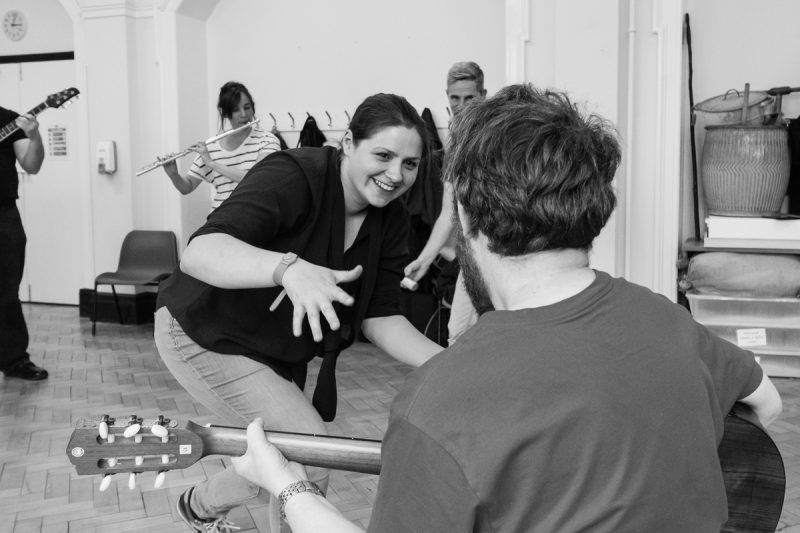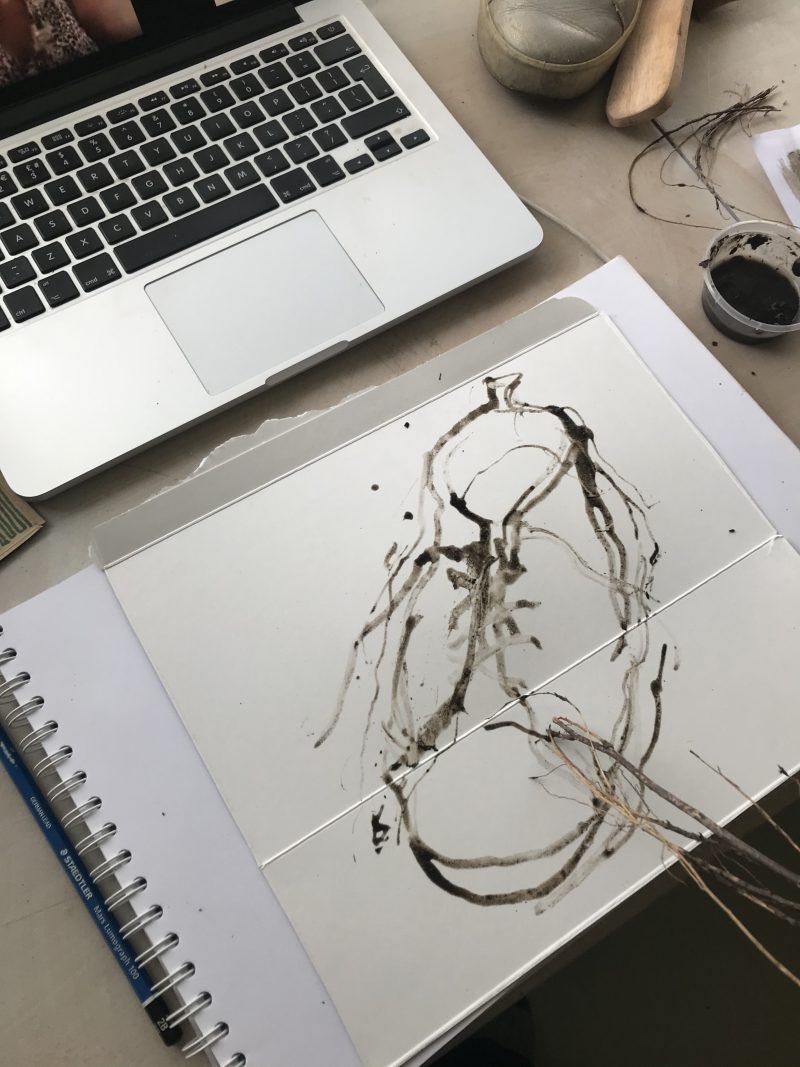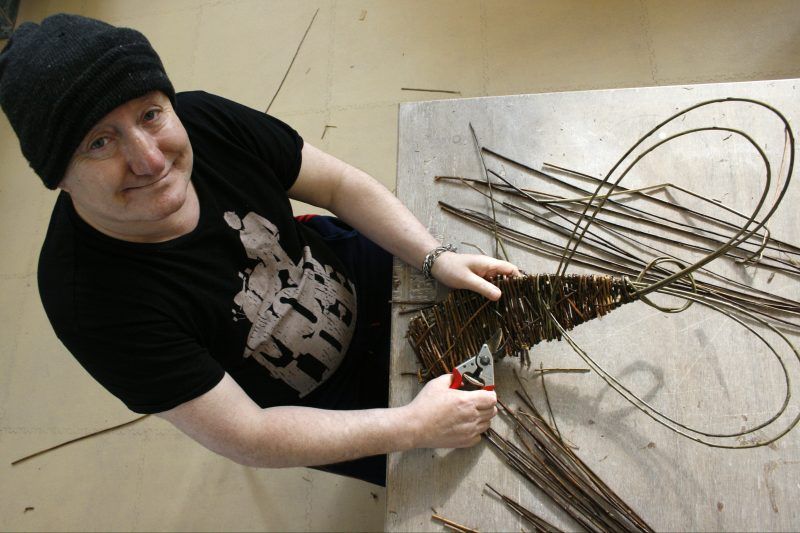“Outside the front door of our studio there are colourful planters with flowers and vegetables. When you open the front door, there is a short corridor, lined with bags of clay. There is an area with coat hooks, and shelves of fired work waiting for collection. Entering the studio, there’s always someone making something, and usually someone having a brew.
These informal thresholds, and the associated rituals, are almost absent in online work. We don’t spend time squidging a bag of clay, chatting whilst taking off our coats or browsing fired work.
Online, we move from our own rooms and our own thoughts to a shared space in a matter of seconds. Suddenly, we are on camera, and creating.
How can we manage this transition?” British Ceramics Biennial
From conversations we’ve had with arts and mental health practitioners over the last six months, we are aware of a huge amount of learning that has been done to make the transition – from physical spaces to remote – that British Ceramics Biennial eloquently describe above.
We thought it would be useful to collect some of the ideas and advice on delivering work remotely from a few different organisations. Thank you to Art Angel, BCB, Chilli Studios, Creative Future, Hoot, North Tyneside Art Studio, Soundcastle and START Inspiring Minds Salford and for their thoughts!
The following themes emerged from their contributions.
-
Creating a safe space for participants
There are different aspects to this – both social/human and technical.
Art Angel, Chilli Studios and North Tyneside Art Studio all emphasised the importance of staff and sessional artists being known to members.
[Art exercises] were all presented by staff that people would know and feel comfortable with.
Art Angel
Chilli Studios explained why this was so important for them:
The participants must feel able to open up and bring elements of their own lives and experiences into the safe space, allowing for any concerns and worries to be mutually explored. Humour and laughter are promoted whilst being always aware of possible triggers or conflicts within the group of participants (all of which staff have a reasonable knowledge of).
Chilli also told us that in normal times freelance artists are encouraged to develop a real sense of the person they are working with and to respond to that as they start to work together. New creative based relationships have been harder to cement remotely, though existing relationships transferred well.
Technology also has a role to play in making online spaces feel safer.
North Tyneside Arts initially started with live Facebook sessions but then moved to closed Zoom-based workshops. They said: “this was a direct response to members who requested a more interactive and safer forum, that at least in part offered a sense of the community and familiarity that the physical Studio offers.”
Soundcastle have found that the ‘gallery view’ on Zoom can be confrontational, making sharing ideas scarier as there is nowhere to hide or blend. They have been using breakout groups, polls and new facilitation approaches to make the creative process as safe and accessible as possible.

NB: On online safeguarding, the Culture, Health and Wellbeing Alliance have useful guidance.
-
Creating a comfortable online space and making it social
There is a likely a close connection between feeling safe and feeling comfortable and able to enjoy the social aspect of taking part.
Charlotte Fowell of the Early Intervention Team in North Staffordshire who worked with British Ceramics Biennial notes the importance of making sure there is plenty of space for checking in and chatting during live sessions, but also recognising that:
Some people prefer to watch and listen in the background but during the session, we try to make sure that everyone who wants to share their work and speak can do so.
Soundcastle have done a lot of thinking about how they themselves facilitate sessions. They say:
Re-emphasise how to interact generously. It is easy for disconnect to occur online and for ‘Zoom face’ to trigger anxiety and fear. We’ve been exploring facial warm-ups to highlight this and actively encourage generous feedback. We are re-working our facilitation approach to put enhanced focus on our visible responses.
Genuine eye contact isn’t possible. So what’s the next best thing? We’ve been encouraging people to actively share their responses and, as facilitators, learning not to rely so purely on instincts as a Zoom room is more challenging to read. Keep smiling/visibly listening.
A lot of people have told us about ‘extracurricular’ non-arts activities that have sprung up among participants or that they have organised. Chilli Studios told us that over the weeks a few social activities have developed, e.g. regular quiz and ‘live mic night’ sessions, which have “intrinsically the feel of belonging to members”. These kinds of activities could help to create a greater sense of ease and familiarity when people come to creative sessions online.
-
Clear communication
This might be setting clear expectations about what participants can expect, so they can decide whether or not to take part, and can prepare things they might need. It might also, as Chilli Studios do, mean discussing and sharing timetables with members in advance. START in Salford send out a couple of weekly newsletters (by post and by email) to help keep participants informed about everything that is going on.

-
Offering flexible and inclusive options to take part
Like many other participatory arts organisations, the organisations we asked emphasised the importance of offering alternative forms of delivery, particularly post, for those who can’t use the internet easily.
Art Angel in Dundee told us they started off with a purely online response, but:
we became uncomfortable with internet only. Many of the people we see cannot afford broadband or smart phones nor have safe access to internet, so we went back to pieces of paper through the post – we can’t over emphasise the popularity and success of this initiative; allowing us a far more intimate and friendly tone, more in keeping with who and what we are.
Chilli Studios deliver regular creative and wellbeing packs called “Chillitunities” which include creative materials linked to workshops and also some basic essentials.
As well as using a full range of digital channels and their own online wellbeing hub, START in Salford are now posting art materials out – and plan to increase the number of posted resources – and have set up an art material collection point as well. They are also transcribing their weekly YouTube activity videos to allow them to be sent in the post to people who don’t have internet access.
START are also considering how they can support people who might struggle to access their offer in other ways, for example creating audio instructions to go with the activities on their online hub to meet the needs of those whose literacy skills might be a barrier to using the site.
-
Art form matters
Several contributors noted that they needed to approach different art forms differently. Creative writing transferred particularly easily online. Creative Future in Brighton, for example, decided to focus on creative writing provision with workshops selling out in less than an hour; but decided to postpone their visual arts sessions. Chilli Studios also say that, ‘interestingly certain activities which suit more verbal discussion, like creative writing and Photography has been able to remain very similar’.
-
Encouraging new joiners
How do you encourage and engage new participants in an online world? And particularly when knowing the artist/facilitator is so helpful for creating a comfortable and safe experience? This is a question a couple of contributors raised. START are hoping that their postal offer and art material collection point might be an easy way in for involving people with START before they physically attend the service. On the other hand, Hoot have developed the Hoot from Home platform which they hope in the future has the potential to be a ‘bridge offer’ connecting them to hard-to-reach referrals who might struggle to attend Hoot in person initially.

Contributors to this blog are keen to get back to ‘normal’:
Nothing will replace the face to face interventions that we are renowned for in Salford, and the benefits people feel as they work alongside peers and friends within studios and community rooms – we miss welcoming people into our building, we have created a place where people feel safe and more able to be themselves – and we can’t wait to get back.
START
Remotely was never an Art Angel word.
But they also feel they have created useful new ways of providing services that they will continue in different ways, which we hope others might also find useful.
Your thoughts
We are interesting in refining this further – particularly looking at the micro-level of how you facilitate safe, comfortable and creative spaces online. Do get in touch if you’d like to share experience.
With thanks to:
Sarah Fraser (British Ceramics Biennial Associate Artist), Charlotte Fowell, Support, Time & Recovery Worker Early Intervention Team North Staffordshire Combined Healthcare NHS Trust, and Kat Evans (British Ceramics Biennial Health Programme Manager).
Michelle Dennett, START Inspiring Minds, Salford
Matt Friedson, Creative Future
Paul Hillier, North Tyneside Art Studio
Tor McKenzie, Hoot Creative Arts
Rosie Summerton and Derek Ramsay, Art Angel
Bob Malpiedi, Chilli Studios
Rachael Perrin, Soundcastle